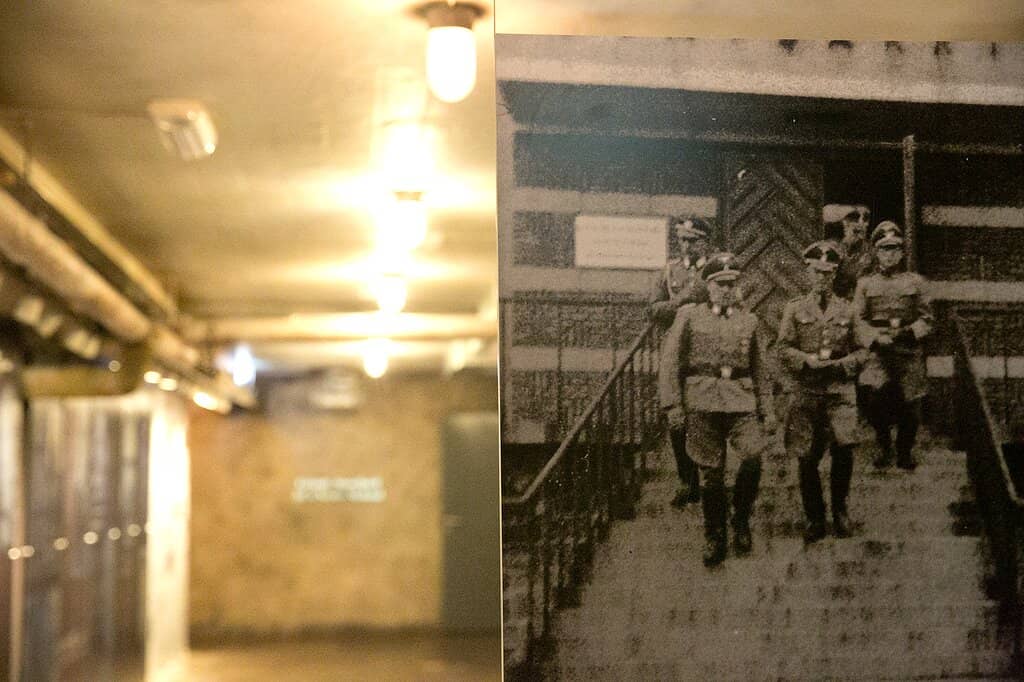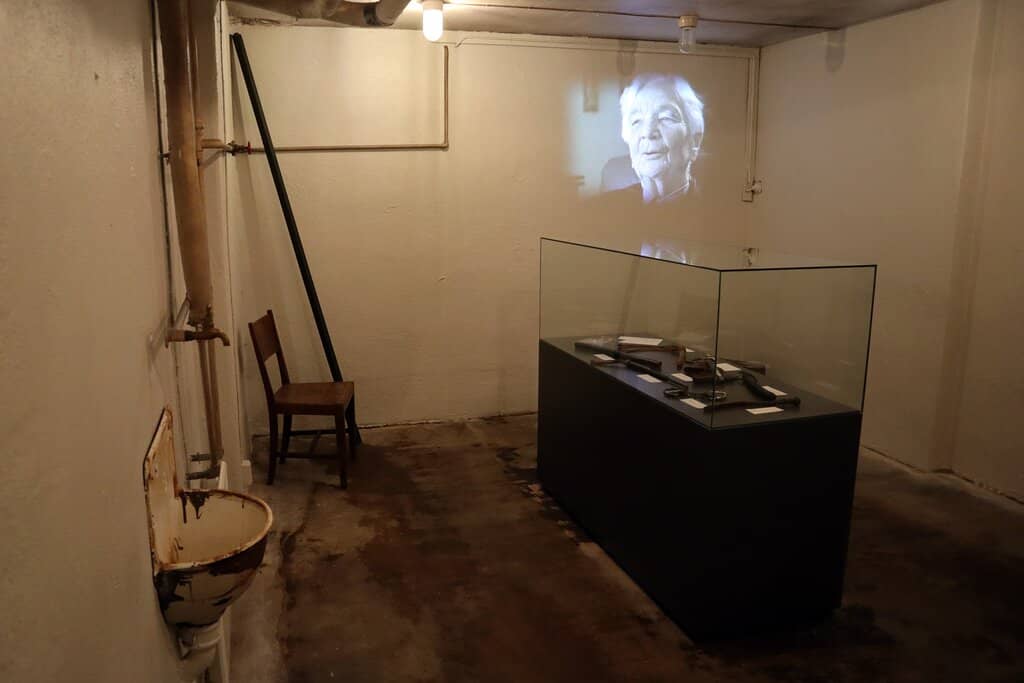
Arkivet Peace and Human Rights Center
Arkivet explores the German occupation of Kristiansand, focusing on the Gestapo, resistance, and collaborators, while also promoting peace and human r...

Highlights
Must-see attractions

Social
From TikTok & Reddit
Best Time
Fewer school groups

Arkivet Peace and Human Rights Center
Best Time
Fewer school groups

Highlights
Must-see attractions
Arkivet explores the German occupation of Kristiansand, focusing on the Gestapo, resistance, and collaborators, while also promoting peace and human rights.
"Harrowing but very interesting, giving a good appreciation of the horrors of war and occupation."

Allocate Enough Time
Plan for at least 2 hours to absorb the exhibits fully. :stopwatch:
Consider Age Appropriateness
Not recommended for young children or those sensitive to graphic content. :warning:

Highlights
Discover the most iconic attractions and experiences

Gestapo Headquarters Exhibition
Main exhibition hall
Explore the chilling history of the Gestapo's command center during WWII in Southern Norway.

Norwegian Resistance Stories
Various displays
Discover the bravery and sacrifices of the Norwegian resistance fighters.

Collaborators' Perspectives
Dedicated sections
Understand the complex and often controversial roles of Norwegian collaborators.
Plans like a pro.
Thinks like you
Planning Your Visit
Understand the Focus
Prepare for the Experience
Best Times
Insider Tips
from TikTok, Instagram & Reddit
Allocate Enough Time
Plan for at least 2 hours to absorb the exhibits fully. :stopwatch:
Consider Age Appropriateness
Not recommended for young children or those sensitive to graphic content. :warning:
Engage with Staff
Guides are knowledgeable and offer deep insights into the occupation. :bustsinsilhouette:
Proximity to Ferry
Conveniently located near the ferry terminal for a quick visit. :ferry:
Tips
from all over the internet
Allocate Enough Time
Plan for at least 2 hours to absorb the exhibits fully. :stopwatch:
Consider Age Appropriateness
Not recommended for young children or those sensitive to graphic content. :warning:
Engage with Staff
Guides are knowledgeable and offer deep insights into the occupation. :bustsinsilhouette:
Proximity to Ferry
Conveniently located near the ferry terminal for a quick visit. :ferry:
What Travellers Say
Reviews Summary
Visitors find Arkivet to be a harrowing yet incredibly informative museum detailing the German occupation of Kristiansand, with a strong focus on the Gestapo and Norwegian resistance. While the graphic nature of some exhibits makes it unsuitable for younger visitors, many praise the depth of information and the knowledgeable staff for providing a profound understanding of wartime horrors and the importance of human rights.
"Small museum telling the history of the German occupation of the city with a focus on the Gestapo. It focuses on the individual stories of the Gestapo officers and men and on the Norwegian resistance and collaborators."
Alan Dennis, Baron of Cowie
"All of Norway's high school students visit a Holocaust Concentration Camp to develop an understanding of what happened during World War II. The King of Norway was a refugee twice- first leaving for England, then for the U.S. A visit to the War Relics of Kristiansand, Norway is invaluable, including the Arkivet."
E K
""Arkivet" was the Gestapo headquarters for the southern parts of Norway during ww2. Today they have an exhibition. In addition they have courses on the war, human rights and cultural awareness for pupils and students. They have a small cafe and gift shop. The building is a short walk from the ferry terminal, so if you have an hour or two to spend, I strongly recommend a visit."
jan erik johannessen
What People Like
What People Dislike
Frequently Asked Questions
🚇 🗺️ Getting There
Arkivet is conveniently located a short walk from the Kristiansand ferry terminal, making it easily accessible for travelers arriving by sea. If you're coming from the city center, it's also a manageable walk or a short bus ride.
Information on specific parking availability near Arkivet can be limited. It's advisable to check local parking apps or inquire upon arrival, especially if you are driving into Kristiansand.
Yes, due to its proximity to the ferry terminal, Arkivet is a feasible option for a visit during a port stop, provided you have a couple of hours free.
🎫 🎫 Tickets & Entry
Opening hours can vary, so it's best to check the official Arkivet website or contact them directly for the most up-to-date information on their operating times.
Admission fees are typically charged. Check the Arkivet website for current ticket prices and any potential discounts for students or seniors.
While advance booking might not always be mandatory, it can be a good idea, especially during peak tourist seasons or if you are part of a group, to ensure entry.
Yes, guided tours are often available and highly recommended. The guides provide extensive information about the Nazi occupation and the Gestapo's activities.
Arkivet is a significant educational resource and frequently hosts school groups, offering courses on war, human rights, and cultural awareness.
🎫 🧭 Onsite Experience
The museum focuses on the German occupation of Kristiansand during WWII, with a particular emphasis on the Gestapo's operations, the Norwegian resistance, and the role of collaborators.
Yes, the museum contains graphic images and details of torture and wartime atrocities, making it unsuitable for young children or sensitive individuals.
Visitors typically spend around two hours at Arkivet to fully explore the exhibits and read the information provided.
Photography is generally discouraged or prohibited inside the museum, especially in areas with sensitive exhibits, as it can be considered inappropriate.
Arkivet has a small cafe and a gift shop where you can purchase souvenirs or refreshments.
🍽️ 🍴 Food & Dining
Yes, Arkivet has a small cafe on-site where visitors can purchase refreshments and light snacks.
Given its central location in Kristiansand, you'll find various dining options in the vicinity. Explore the city center for a range of cafes and restaurants.
📸 📸 Photography
Photography is generally not permitted inside the museum, particularly in areas displaying sensitive historical content. It's best to respect the rules to maintain the solemn atmosphere.
While interior photography is restricted, the exterior of the building and the surrounding Kristiansand area offer opportunities for capturing the city's atmosphere.
For Different Travelers
Tailored advice for your travel style
👨👩👧 Families with Older Teens
Key recommendations: Prepare your teens for the mature themes and graphic imagery. Encourage them to engage with the exhibits and discuss their thoughts afterward. The knowledgeable staff can also provide context and answer questions, making the visit more impactful.
📚 History Enthusiasts & Students
Key recommendations: Allocate ample time to read through all the displays. Consider attending a guided tour for deeper insights. The center's focus on human rights also provides a broader context for understanding the consequences of conflict and oppression.
🚶 Day-Trippers from Ferry
Key recommendations: Ensure you have at least 2-3 hours available. Since photography is restricted, focus on absorbing the information and stories. The cafe offers a brief respite before or after your visit.
Deep Dives
In-depth insights and expert knowledge
The Gestapo's Role in Kristiansand
The displays often focus on the individual stories of Gestapo officers and their actions, providing a chillingly personal perspective on the occupation. This approach helps to humanize, in a disturbing way, the perpetrators and the machinery of oppression, making the historical accounts even more impactful.
It's crucial to approach this part of the exhibition with an awareness of the sensitive and often graphic nature of the content. The aim is to educate about the realities of wartime atrocities and the importance of remembering these events to prevent their recurrence.
The Norwegian Resistance Movement
Visitors can learn about the courage and ingenuity of these individuals and groups who worked tirelessly to undermine the German regime. The exhibition often features personal accounts, artifacts, and photographs that bring their stories to life, emphasizing their vital role in the fight for Norway's freedom.
Understanding the resistance movement provides a crucial counterpoint to the narrative of occupation and collaboration, showcasing the enduring spirit of defiance and the fight for human rights even in the darkest of times.
Understanding Collaboration and Human Rights
Beyond the historical context of WWII, Arkivet also serves as a Peace and Human Rights Center. This broader mission involves educating visitors about contemporary human rights issues, promoting peace, and fostering cultural awareness. The center hosts educational programs and exhibitions that connect historical lessons to present-day challenges.
The dual focus on historical occupation and ongoing human rights advocacy makes Arkivet a unique institution. It uses the past as a powerful tool to reflect on the importance of peace, justice, and the protection of fundamental human rights for all.






Social
from TikTok, Instagram & Reddit